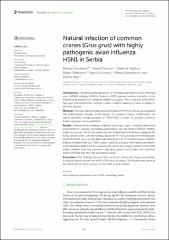| dc.contributor.author | Đurđević, Biljana | |
| dc.contributor.author | Petrović, Tamaš | |
| dc.contributor.author | Gajdov, Vladimir | |
| dc.contributor.author | Vidanović, Dejan | |
| dc.contributor.author | Vučićević, Ivan | |
| dc.contributor.author | Samojlović, Milena | |
| dc.contributor.author | Pajić, Marko | |
| dc.date.accessioned | 2024-12-12T09:27:43Z | |
| dc.date.available | 2024-12-12T09:27:43Z | |
| dc.date.issued | 2024 | |
| dc.identifier.citation | Djurdjević B, Petrović T, Gajdov V, Vidanović D, Vučićević I, Samojlović M and Pajić M (2024) Natural infection of common cranes (Grus grus) with highly pathogenic avian influenza H5N1 in Serbia. Front. Vet. Sci. 11:1462546. doi: 10.3389/fvets.2024.1462546 | en_US |
| dc.identifier.issn | 2297-1769 | |
| dc.identifier.uri | https://repo.niv.ns.ac.rs/xmlui/handle/123456789/905 | |
| dc.description.abstract | Introduction: The late autumn epizootic of the highly pathogenic avian influenza
virus (HPAIV) subtype H5N1 in Serbia in 2023 caused massive mortality in the
migratory population of common cranes (Grus grus). This is the first time HPAIV
has been identified in the common crane in Serbia, leading to mass mortality of
this bird species.
Methods: To understand the pathological impact of HPAIV in cranes, we evaluated
the pathological changes in the tissues of common cranes. Additionally, we
report genomic characterization of HPAI/H5N1. In total, 14 juvenile common
crane carcasses were examined.
Results: Infected birds primarily exhibited neurologic signs, including ataxia and
incoordination. Grossly, necrotizing pancreatitis was the most common finding,
while microscopic lesions included necrosis, inflammation and hemorrhages in the
lungs, spleen, brain, liver and kidneys. Based on RT-PCR, all birds were infected with
the HPAI H5N1 virus, as viral RNA was detected in all 14 selected tissues. Genetic
analysis revealed that our H5N1 isolate could be grouped with highly pathogenic
avian influenza clade 2.3.4.4b, subgroup DA, and is very closely related to the H5N1
strains isolated from the common crane and turkey from Croatia, the common
crane from Italy and the Ural owl from Slovakia.
Discussion: Our findings showed that common cranes are highly susceptible
to natural infection with the HPAI H5N1 virus of clade 2.3.4.4b and may serve as
bio-sentinels for the presence of the HPAI virus in wildlife. | en_US |
| dc.description.sponsorship | This study was
funded by the Ministry of Education, Science and Technological
Development of the Republic of Serbia by the contract of
implementation and funding of research work of NIV-NS in 2024,
contract no. 451-03-66/2024-03/200031, and by the Provincial
Secretariat for Higher Education and Scientific Research, Autonomous
Province of Vojvodina, contract number: 142-451-3483/2023-01/1. | en_US |
| dc.language.iso | en | en_US |
| dc.source | Frontiers in Veterinary Science | en_US |
| dc.subject | avian influenza | en_US |
| dc.subject | common cranes | en_US |
| dc.subject | H5N1 | en_US |
| dc.subject | pathology | en_US |
| dc.subject | Serbia | en_US |
| dc.title | Natural infection of common cranes (Grus grus) with highly pathogenic avian influenza H5N1 in Serbia | en_US |
| dc.type | Article | en_US |
| dc.identifier.doi | 10.3389/fvets.2024.1462546 | |
| dc.citation.volume | 11 | en_US |
| dc.citation.spage | 1462546 | en_US |
| dc.citation.rank | M21 | en_US |
| dc.type.version | published | en_US |

